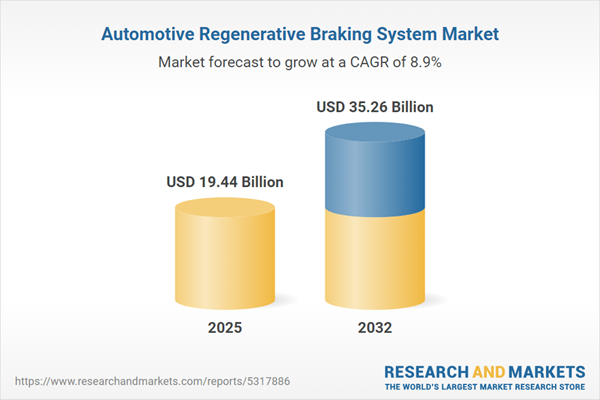Speak directly to the analyst to clarify any post sales queries you may have.
The automotive regenerative braking system market empowers senior leaders to drive operational efficiency, compliance, and sustainability in fleet and mobility transformation strategies. Organizations adopting these solutions strengthen resilience and gain an edge in meeting evolving regulatory and performance requirements.
Market Snapshot: Automotive Regenerative Braking System Market Performance
The global automotive regenerative braking system market reached USD 17.85 billion in 2024, supported by a compound annual growth rate of 8.87%. This growth reflects increased prioritization of energy recovery solutions to address evolving regulatory standards. Automotive manufacturers are adapting system architectures to accommodate both commercial and personal vehicle demands, ensuring alignment with current sustainability goals while responding to dynamic operational contexts. Key stakeholders, including large-scale fleet operators and mobility service providers, are focusing on robust technologies that contribute to reduced emissions and continuity of business operations in a changing mobility landscape.
Scope & Segmentation
- Vehicle Types: Includes commercial fleets and passenger vehicles such as hatchbacks, sedans, SUVs, and multipurpose models. Commercial adoption is propelled by the drive to minimize total cost of ownership, while personal vehicles are influenced by growing awareness of fuel efficiency and compliance with sustainability policies.
- Propulsion Types: Applications extend across battery electric vehicles, hybrid electric vehicles, and plug-in hybrids. Each category leverages regenerative braking to maximize electric powertrain efficiency, adapting to diverse fleet compositions and mobility scenarios.
- System Types: Encompasses mechanical regenerative braking, electrical kinetic energy recovery, and regenerative anti-lock braking. These technologies support modernization for both established commercial assets and new vehicle introductions, enabling seamless transitions without major operational interruptions.
- Sales Channels: Includes OEM installation and aftermarket retrofitting, allowing organizations to time technology integration with planned asset renewals or incremental upgrades. This supports coherent financial planning and operational alignment.
- Regions: Robust growth is observed in Asia-Pacific, bolstered by government incentives and strong regulatory initiatives in China, Japan, and India. The Americas and EMEA also see steady expansion as compliance policies and environmental mandates drive further adoption.
- Companies Profiled: The landscape features leaders such as Robert Bosch GmbH, Continental AG, ZF Friedrichshafen AG, DENSO Corporation, Hitachi Automotive Systems, Valeo SA, Mitsubishi Electric Corporation, BorgWarner Inc., Aisin Seiki Co., Ltd., and Schaeffler AG—each shaping technological advancement and market direction.
Key Takeaways for Senior Decision-Makers
- Adoption of regenerative braking solutions provides direct pathways for enhanced emissions compliance and supports alignment with current and future sustainability frameworks.
- Modular system architectures enable swift integration of evolving technologies, helping organizations sustain performance as operational priorities change.
- Advancements in vehicle control and power electronics are improving operational efficiency and providing measurable benefits to both operators and end users.
- Strategic partnerships among automakers, suppliers, and technology firms enhance scalability, accelerating response to both regulatory developments and market demand.
- The combination of OEM and aftermarket sales channels allows tailored deployment in sync with asset management and procurement cycles.
- Regional adaptation remains crucial, as responding to diverse regulatory environments strengthens competitive positioning and risk management across markets.
Tariff Impact: Navigating U.S. Trade Policy Shifts
Recent U.S. tariffs on automotive components have led manufacturers to reassess their sourcing and supply chain strategies. Senior leaders are prioritizing domestic production and building reliable supplier relationships to mitigate risk. Balancing short-term cost objectives with long-term supply chain flexibility is increasingly critical as trade policies evolve.
Methodology & Data Sources
This report is grounded in industry research, expert interviews, and systematic financial analysis. Scenario modeling and secondary research ensure an objective evaluation of shifting technology adoption, competitive pressures, and the main influences reshaping the automotive regenerative braking system market.
Why This Report Matters
- Equips senior executives and technical teams with actionable insights to guide investment, sourcing, and procurement in regenerative braking system strategies.
- Offers practical guidance for technology integration and supply chain management across different operational contexts, highlighting implementation considerations.
- Facilitates evidence-based innovation and expansion planning through detailed market segmentation and regional trend analysis.
Conclusion
Through targeted adoption of regenerative braking systems, organizations enhance sustainability compliance and operational effectiveness. Prioritizing agility and collaborative partnerships positions decision-makers to meet evolving requirements within the global mobility environment.
Additional Product Information:
- Purchase of this report includes 1 year online access with quarterly updates.
- This report can be updated on request. Please contact our Customer Experience team using the Ask a Question widget on our website.
Table of Contents
3. Executive Summary
4. Market Overview
7. Cumulative Impact of Artificial Intelligence 2025
Companies Mentioned
The companies profiled in this Automotive Regenerative Braking System market report include:- Robert Bosch GmbH
- Continental AG
- ZF Friedrichshafen AG
- DENSO Corporation
- Hitachi Automotive Systems, Ltd.
- Valeo SA
- Mitsubishi Electric Corporation
- BorgWarner Inc.
- Aisin Seiki Co., Ltd.
- Schaeffler AG
Table Information
| Report Attribute | Details |
|---|---|
| No. of Pages | 191 |
| Published | October 2025 |
| Forecast Period | 2025 - 2032 |
| Estimated Market Value ( USD | $ 19.44 Billion |
| Forecasted Market Value ( USD | $ 35.26 Billion |
| Compound Annual Growth Rate | 8.8% |
| Regions Covered | Global |
| No. of Companies Mentioned | 11 |









